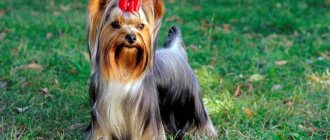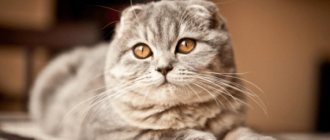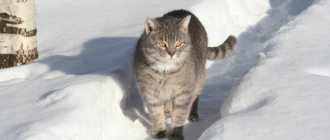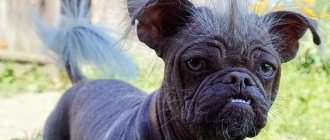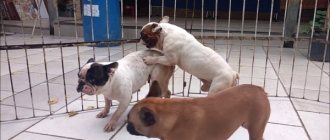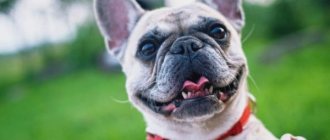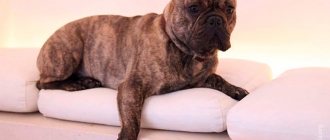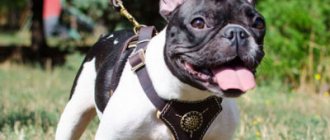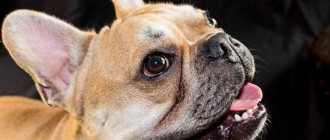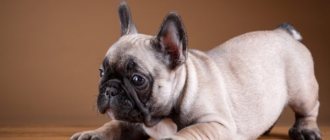Dogs of the French Bulldog breed are a little formidable on the outside, thanks to the folds and a peculiar groove on the muzzle, but they are kind on the inside. Possessing a multifaceted character, this pet can become a wonderful companion in the life of any person. But at the same time, it can cause some inconvenience. For example, behave aggressively towards other animals. Today we will tell you what other advantages and disadvantages exist in representatives of this breed.
Description of the French Bulldog breed
Popularity 82nd among 263 dog breeds
Lifespan:
10-12 years
Breed group:
Decorative
Height:
30-35 cm
Country of origin:
France
Average price:
15-25 thousand rubles
Weight:
8-14 kg
Latest articles Cat health
Ataxia in cats: what is it, how does it manifest and is treated 01/23/2022 187 0 0
Cat health
Leukemia, or viral leukemia in cats 01/23/2022 162 0 0
Dimensions and weight
French bulldogs are far from giants.
These are small indoor dogs belonging to decorative breeds.
The height at the withers for males is 27-35 cm, and the weight is 9-14 kg . Females grow to 24-32 cm and weigh from 8 to 13 kg.
There are also dwarf French bulldogs. Read about them here.
Advantages and disadvantages
- Pros:
- small size and the ability to be kept in a small apartment;
- good security skills;
- easy and inexpensive care;
- cheerful disposition, perfectly combined with intelligence;
- devotion and obedience.
- Minuses:
- do not tolerate cold and heat well;
- snores and sniffles due to being a brachycephalic;
- increased salivation;
- not very good health, including allergies to food and flowers.
Nicknames for the "French"
For girls: Ada, Betsy, Bona, Wendy, Hera, Gerda, Dora, Eva, Jessie, Zena, Irma, Kerry, Cora, Questa, Lara, Lucky, Maggie, Martha, Nessie, Nika, Lola, Martha, Polly, Peggy , Runa, Rada, Tori, Siba, Fanny, Heidi, Yanta, Yaffie.
For boys: Axel, Archie, Artie, Barney, Burke, Buddy, Bingo, Wulf, Walter, Hector, Gucci, Greddy, Dart, Ginny, Dante, Dixie, Jacques, Zeus, Zorro, Clyde, Quest, Larry, Lloyd, Mark , Nemo, Nero, Oddie, Patrick, Silver, Torch, Feint, Fly, Eugene.
“Count on boys and girls!”
Key facts
The French are smart and intellectually developed, but they achieve their goals with rare persistence. They are as stubborn as they are curious. They don't like monotony. When training, you will have to use your imagination to maintain the dog’s interest.
The description of the French bulldog breed says that the dogs do not require high activity during walks. You can safely walk with them on a leash and not have races. To prevent your pet from gaining excess weight, it is enough not to overfeed it.
Like many brachycephals, they have breathing problems and have difficulty withstanding high temperatures. The Frenchie is not suitable for keeping in hot climates.
There is practically no noise or noise from these dogs, except for snoring - they are not empty-nesters. You can’t call them neat people either, so if you can’t even imagine your expensive sofa slobbering on and covered in wool, you’re unlikely to be happy with the Frenchman.
The characteristics of the French Bulldog breed are as follows: it is a purely domestic companion dog. He is not suitable for street keeping, and the idea of putting this dog on a chain cannot even come to mind.
The French Bulldog is very attached to its owners and people in general. If he is alone for a long time, he will begin to feel very sad and may even get sick.
The Frenchie gets along well with children and animals. Rather, you need to ensure that a small child does not accidentally injure the dog, rather than vice versa.
The lifespan of a French bulldog is not too long: only 10-12 years. But you can always make a dog long-lived with excellent care and a lot of love.
Character and habits
“Frenchies” are distinguished by high sociability, they love to be in the center of attention and constantly attract it to themselves. If all family members are at home, the bulldog will behave actively and noticeably. He doesn't like being alone. This is not a dog that will lie on its rug for a long time or “chase” a bone and a ball alone. She needs a playmate.
If there are children at home and the pet is well-bred, it will become an excellent nanny and entertainment for the kids. But children should behave carefully: do not take away toys by force, do not hit or “ruffle” the dog. This is a fighting breed, innate reflexes can manifest themselves, the dog will actively defend itself and can injure.
Child of a French Bulldog and a Human
The playful, active nature of the French Bulldog is harmoniously combined with high emotional potential, attentiveness and affection for the owner. The pet subtly senses the mood of its household members. If he sees that someone is sad, he will actively entertain the person and make him smile. This trait in the Frenchie has conquered thousands of families; it is in 21st place in terms of prevalence in homes.
If the dog sees that the owner is working intently on something, then for the sake of his desire to play, he will not distract him and will rather wait for other family members or for the hour when he is free. You shouldn’t think that a French bulldog is an animal that will endlessly distract you from business and turn your house into a playground. This dog is understanding, knows how to wait and listen to instructions from loved ones.
French bulldog with household members
Absolute pride, combined with sincere affection and understanding - this is what characterizes this breed. The pet demands deep respect. When harassed and beaten at home, it becomes aggressive and can even bite a member of the owner’s family.
“Frenchie” will not tolerate the presence of another animal in the house
He remembers grievances for a long time and does not forgive, especially undeserved punishments. It can take revenge on the offender after a long time, when he has already forgotten about the damage done to the dog. If you are determined to communicate with a dog on an equal basis, respect it and not use violence, then this is the very breed that will allow you to acquire in it a true friend, faithful and devoted, ready to protect you at the cost of your own life.
Important! There is one “but”. "French" is jealous. He will not tolerate the presence of another animal in the house, he will oppress him, express aggression in the struggle for the love and attention of the owner.
“French” is ideal for a single person. He will brighten up his life and become a true friend. In families with children, it will be a real holiday for the kids - playing active games with them. It will be difficult for a married couple with a dog. She will begin to be jealous of one owner towards another, accumulate grievances and experience a lack of attention.
French bulldog kissing owner
History of the origin of the French bulldog
There are several versions of the origin of the French bulldog. According to one of them, the direct ancestor of the Frenchman was an Old English bulldog, used in dog fighting. After this entertainment was banned, breeders began to select the smallest dogs for mating, which were more convenient to keep as a companion. A description of Sir Stubbs's dogs has been preserved, which is almost identical to the description of the French bulldog. In 1860, another Londoner brought these dogs to France.
According to another version, the Frenchies were bred directly in France from other bulldogs - the already extinct Spanish Alans. These were large dogs that took part in bullfights. In particular, there were Burgossian fighting bulldogs, which are very similar to the French ones.
The third version says that the bulldogs were brought by workers from England who fled to France in search of work. In France, the pug, some terriers and other small breeds were added to the blood of the English bulldog. The courtesans liked the cute dogs - many images of half-naked maidens with dogs that looked very much like the French have been preserved. High society adopted the fashion for bulldogs from courtesans. Its popularity has made the Frenchie a very expensive breed.
French bulldogs were first exhibited in 1896 in England. In 1904, they were identified as a separate breed, and the FCI recognized the French as the founders of the breed. From Paris the bulldogs began their triumphal march around the world. In 1890, they were brought to the USA, and there they were also very expensive - a French bulldog cost more than a Ford Model T car, sometimes several times.
One of the representatives of the breed traveled on the Titanic, which is confirmed by archival records. Unfortunately, the dog drowned, but he was insured for a large sum, and the owner received large compensation for those times.
In the Russian Empire, the Frenchman was also a dog of the elite. French bulldogs were kept by Chaliapin and Mayakovsky. There was a representative of this breed in the royal family - Grand Duchess Tatyana Nikolaevna adored her favorite Ortino. Ortino had a collar inlaid with semi-precious stones, and Tatiana herself had a collection of figurines of her favorite breed by Faberge.
The last time Ortino was mentioned in documents was two months before the execution of the royal family. His fate is unknown; most likely, he shared the fate of his mistress. Subsequently, the “elitism” of the dog did it a disservice - under Soviet rule it was not held in high esteem as an element of bourgeois luxury, and the breed practically disappeared.
After the Great Patriotic War, there was only one male French bulldog left in the entire Soviet Union. From him and a bitch imported from Hungary, the first post-war litter was obtained. The owner of one of the babies was N. Sklifosovskaya, who played a huge role in the revival of the breed in the USSR. In the 1960s she imported a couple of Frenchies and started breeding. In 1995, the All-Russian Breed Club was created.
History of the breed
There is no consensus regarding the origin of French bulldogs.
The British claim that they appeared as a result of changes in toy bulldogs, the French insist that the breed arose as a result of the use of Spanish bulldogs that do not exist today in the breeding and they are responsible for this.
The first owners of French bulldogs were English dressmakers, who used them to catch rodents. Later, many dressmakers took the “Frenchies” with them, moving to France, where representatives of this breed fell in love with the local nobility and quickly gained popularity.
The breed was officially registered in France, which explains its name.
Appearance of a French Bulldog
General impression
The first French Bulldog standard was created in 1898. The standard in its modern form has existed since 1987. It was slightly changed and supplemented in 1995 and 2012. For the Russian Federation, the official FCI standard is supplemented with comments and drawings by E. V. Makhanko, A. B. Shavolin and V. N. Saranchi.
This is a small, proportional, powerfully built dog. It has the appearance of a molosser with a compact size. Even in the photo, the French bulldog looks like an active and energetic dog with an intelligent look.
Head
The head is massive, it can be mentally fit into a square. The back of the head is almost flat, the forehead, on the contrary, is convex, with a clear stop. The nose is short and upturned, black in color. The maximum length of the nose is ⅙ of the height of the forehead. A nose of a different color or forked is considered a serious fault. Another drawback is that the nostrils are too narrow, which can cause the dog to have breathing problems.
Folds extend from the nose along the muzzle, but they should not rise above eye level. Wide, powerful jaws must be accompanied by an overbite - other types of overbite are not allowed. With the mouth closed, the teeth and tongue should be tightly covered with black lips and not stick out. Due to the shortened muzzle, the French have an incomplete dental formula - 40 teeth instead of 42.
Only spotted dogs can have white spots on the face. The eyes are round in shape, slightly protruding, but in no way protruding, with no visible whites. The expression is intelligent and inquisitive. A bulldog's ears are shaped like tulip petals. They are placed strictly vertically and should not be hanging or pointed.
Neck
The Frenchman's neck is muscular and moderately short. The head should not look tightly pressed to the body, but a neck that is too long is bad. There should be no suspension.
Frame
The body is powerful, slightly elongated in length, and when viewed from above it looks like a pear - so powerful is the back and thin waist. The ribs are well rounded and the underline is tucked. The highest point of the back is in the lower back. The croup is slightly sloping and ends in a low-set tail.
Forelegs
The forelimbs are strong, straight, parallel, slightly turned to the sides. The pasterns should not be turned out. The paw is round and knitted, the toes are not long and splayed. The shoulder is unobtrusively expressed.
Hind limbs
The hind limbs of the French Bulldog are powerful, with well-developed muscles and wide hips. The angle of the hock joint is well defined. When viewed from behind, the feet should not be turned outward and the hocks should not be close together. There should be no dewclaws; their presence or signs of their removal are a serious defect.
Tail
The tail should be lowered below the line of the back in any mood of the dog. The length can be different, with creases and curvatures, but not longer than the hock joints.
Movement
Movements are free and confident, without swaying to the sides. The dog should not mince with small steps or move at an amble. There should be no impression that effort is being made to move.
Wool
The coat is without undercoat, short, smooth, and lies close to the body. Long or wavy coat is a fault.
Color
French bulldogs have many colors, but not all are recognized by canine associations. The main acceptable colors are: white with and without spots, white and brindle, white and fawn, brindle, fawn (from bright red to café au lait), black and brindle. Completely white is classified as spotted. Cream and blue colors are not recognized by cynological organizations, but, for example, in the USA such dogs are well distributed and represented.
Dimensions
The maximum weight of male French bulldogs is 14 kg, females are slightly less - 13 kg. The weight of an adult starts from 8 kg. The height of the French Bulldog ranges from 29 to 35 cm, while females are smaller than males, with lighter bones. Dogs of the opposite sex type are a significant disadvantage. The breed standard calls for restraint in regard to such a shortcoming of bitches as an overly elongated body, since such dogs give birth more easily. The size of French bulldogs makes it easy to keep them in small apartments.
Colors from photos
Although you can find French Bulldogs in a variety of colors, the standard allows only three varieties: brindle, fawn and spotted. All colors with photos and their subspecies are described below.
Brindle (Brindle)
It is formed by alternating stripes. Color varies from wheaten with dark areas to almost black with isolated red hairs.
Fawn (Fauve)
Varies from light biscuit to deep red. There are two types:
- Single color (fawn). The color of the coat is any range of fawn: from gray-milky to bright red.
- With brindle or streaks (brindle). On the main background there are dark transverse stripes. Their number and thickness vary: from single thin to a large number of darkened areas. Similar to brindle, but genetically they are different colors.
Additional Information! With brindle and fawn colors, small light spots on the chest and head, as well as a mask on the face, are acceptable.
Spotted (Caille)
Characterized by the arrangement of colored spots on a white background. It is formed with increased piebaldity: when light areas displace dark ones. There are two types of suit:
- White spots alternate with brindle: white & brindle.
- White areas alternate with fawn: white & fawn.
Sometimes in spotted French bulldogs the white color is so dominant that it displaces all colored areas. Visually, it seems that such dogs are snow-white. In reality, this is not the case: only the fur lacks pigment, and there are noticeable dark spots on the skin.
Personality of the French Bulldog
Frenchies are wonderful companion dogs. The even and friendly nature of the French Bulldog is valued in the world of dog lovers. The bulldog is always ready to play and offer his sides for affection; communication is very important for him.
These dogs are tolerant of other pets and children, making them true family dogs. Who are the French suitable for? Easy to care for, the French Bulldog is an excellent pet for novice dog owners. But a dog languishes when alone, so if you are a busy person, you might want to get a breed that can more easily tolerate lack of companionship.
During a walk, the Frenchman is ready to play with all the dogs, but if he encounters an aggressive opponent, the little bulldog will rush into battle without hesitation. This should be avoided, as bulldogs fight until their last breath, and in a fight with a stronger opponent, your pet may simply die. If a French bulldog has a cocky character, then after a successful fight he may begin to specifically look for a victim - this is another argument why dog fighting should not be allowed.
The Frenchman walks a little. In winter it is cold outside, so you can insulate the dog. Puppies are usually more active and playful, while adult dogs behave imposingly and leisurely.
Conclusion
The French bulldog is a miniature sniffling creature that causes attacks of emotion in those around him. But it is important to understand that this is not only a funny animal.
The baby is not suitable for those who:
- looking for a dog for active sports (running, swimming);
- I’m not ready to pay much attention to my pet because I’m so busy;
- is not going to provide the dog with thorough daily care and feeding;
- looking for a guard dog;
- I prepared a booth for the little “Frenchie” in the fresh air.
A loyal and loving bulldog is another child in the house - cheerful and playful.
Education and training
The French are very smart, plus they have an excellent memory. Unlike working dogs, they get bored doing the same exercises, so short but infrequent repetitions, rewards, and play training will be effective in training and raising a French Bulldog.
French bulldogs successfully participate in mini-OKD and freestyle competitions, and also perform well in agility, but in this sport it is better to use dogs with a more elongated muzzle, albeit less purebred.
The French are born leaders, so you should take the position of leader from the very beginning and not allow your favorite to do so. A leader dog will inevitably have problems with socialization and behavior.
A French Bulldog can be trained to go to the toilet in a litter box at home. When picking up a puppy from the breeder, take care of the safe arrangement of the home, remove all wires, and immediately determine a good, warm and non-traversable place for the dog’s bowl and bed. Ask the breeder for something with the scent of home to make it easier for your baby to adapt. If you don’t want to sleep with a Frenchman for the rest of your life, never take him into bed, no matter how pitifully he whines.
Socialization plays a big role for the Frenchman. The main character traits are formed in bulldogs before they are one year old, so if you try hard the first year and put your soul into the dog, then your reward will be a well-mannered, trained, smart dog.
Looking for a French Bulldog? Find your pet from 1 offer Buy
Color variations
The following color options are approved by the breed standard :
- brindle or motley - the most popular option, in which black and red stripes alternate;
- white with spots of various colors except black;
- Pure white color is acceptable, but very rare;
- fawn - many shades from red to coffee.
Acceptable colors:
- black brindle - the presence of a small number of red hairs on an almost black dog;
- specks in the color of spotted dogs.
Colors considered a breed defect:
- black;
- blue;
- chocolate;
- black and white;
- tricolor;
- lilac;
- gray-blue.
Blue “Frenchies” are very popular, so if you don’t plan to take your pet to exhibitions, you can pay attention to this color.
Health and Diseases of the French Bulldog
Possible diseases
Like many breeds, Frenchies are prone to breed-specific diseases:
- Increased risk of injury.
- Infectious eye diseases. Due to their slightly protruding position, the eyes are more easily injured than in other breeds. Bulldogs are prone to conjunctivitis and third eyelid prolapse. This defect is corrected surgically, and after surgery the eye requires hydration for life.
- Skin diseases, or dermatitis. Dogs with light-colored fur are more prone to them. Expressed in itching and irritation of the skin. There are effective medications for dermatitis.
- Due to the structure of their muzzle, French bulldogs have a serious problem called brachycephalic breathing. The bulldog seems to have difficulty taking every breath. In particularly severe forms, the dog can actually suffocate. This is corrected surgically.
- The French are characterized by deviations in the structure of the spine: vertebrae can be displaced and hemivertebrae formed. Because of this, there is a high risk of injury and curvature of the spine, which can even lead to failure of the hind limbs.
- Allergies also affected the French. They can arise from anything, but can be treated quite successfully with medication.
Knowing the possible risks, you can promptly diagnose abnormalities in your bulldog and take him to the veterinarian. Ideally, you should show your dog to the doctor once every six months.
Reproductive health
In terms of reproductive health, French Bulldog bitches may experience difficult labor, ending in caesarean section.
A Frenchie bitch comes into heat once every 6-7 months; breeding before the third heat is not advisable. Dogs need to be bred on days 11-14. A control mating is done every other day.
Pregnancy in dogs lasts on average 63 days. There is no need to change the bitch’s lifestyle in any way. From the fifth week you can increase the amount of food and make sure that the mother gets enough phosphorus and calcium.
French bulldogs can give birth on their own, but if there are any difficulties, you should immediately contact a veterinarian. Some bitches may refuse to care for the puppies and she will need to be placed with the offspring in a confined space that she cannot leave. Usually within an hour the bitch begins feeding and caring for the puppies. If the maternal instinct does not manifest itself even then, the owners of the bitch will have to feed the puppies. But usually the French are caring parents.
Mating and birth
Puberty in males occurs closer to the age of one. In bitches earlier - in the 6-8 month period. But until the body is fully prepared, mating cannot be carried out. After all, early birth can undermine the health of a bulldog. The unstable psyche of a male dog can be further undermined; the pet will become irrevocably damaged if it is brought in early for breeding. Further, when he smells the heat of a passing bitch, he can break away from the owner and run away. The final formation of the French bulldog’s body ends at the age of 1.5-2 years. It is not recommended to bring dogs until this time.
Pregnancy can occur on one of the days of estrus. The special period lasts about three weeks. The best days for conception are considered to be 12-13 days from the start of estrus. The female's pregnancy lasts 2 months. At this time, you should be more attentive to the dog’s health and nutrition.
Before giving birth, it is necessary to prepare the animal:
- cut your nails;
- shave the hair near the nipples and genitals;
- Wash your pet's body with warm water and soap.
In most cases, the bitch copes with childbirth herself. But if she is weak or does not have enough experience, the owner must help her in this difficult task. The owner should check with a specialist in advance about how to properly remove small puppies so as not to harm them or the mother. Some breeders do not want their pet or pet to have offspring. Each dog owner has different reasons for this. Then there is nothing left to do but sterilize or castrate the dog.
Features of feeding and diet
Due to the tendency to allergies, French bulldogs are best fed once and for all with the selected food that is suitable for the animal. Your breeder or veterinarian will help you choose food. The food should be premium, not chicken. Portion standards for each food are individual. The granules should be small in size.
Dogs should not be given:
- very fatty meat;
- saltiness-smokedness;
- fried food;
- sweets;
- flour products;
- tubular bones;
- river fish.
The breeder only offers complementary foods to one-month-old puppies, and by one and a half to two months they receive 6 meals a day. By six months the puppy is gradually transferred to three meals a day, and at one year - to two meals a day.
Never overfeed your dog to prevent it from becoming obese. Obesity can make French people's breathing problems worse.
Preparing a room for a new family member
The French Bulldog is kept only at home. The dog is a decorative breed for an apartment and is not suitable for living in an enclosure. On the street she freezes, overheats, catches colds and catches infectious diseases.
Where does your French Bulldog sleep?
On your own sun lounger
56.25%
Together with family members on the bed
43.75%
Preparations are made in advance for the arrival of the puppy to its new home and its care. Need to:
- close all cracks and openings - the baby can get stuck between the sofa and the floor, behind the closet and damage his back or joints;
- put metal bars on the windows - the dog can jump out of the balcony, mosquito nets will not hold him in;
- lift the wires from the floor and secure them higher, or hide them in cable channels;
- remove household chemicals, cosmetics, and waste bins from access - the bulldog will not fail to try a “delicious” bottle of shampoo or scraps from the trash, which can lead to poisoning;
- hide valuables - from favorite shoes to expensive cream and memorable figurines: all puppies are naughty, their teeth will definitely end up with objects dear to the owner’s heart.
Keeping and caring for a French bulldog places special demands on the premises. Dogs are sensitive to temperature changes and are prone to dust allergies. Therefore, the apartment should be clean, bright, warm, without drafts.
It's easier with the dimensions of the area. Bulldogs are compact, not active, and do not need much space. A one-room apartment would also be suitable.
The first days are difficult for a puppy. Care at this time is an aid in adaptation. The baby is shown rooms, introduced to family members and other pets, and helped to get used to objects that are unusual and scary for the dog. It is important to explain the rules of behavior to your pet before 4 months - this is the basis of raising a Frenchie.
To help the kitten quickly get used to its new home, take a toy, bedding or bowl from the nursery. Bulldogs are sentimental and get attached to things.
Care and maintenance
Frenchies do not shed at any time; their fur can fall out all year round, so it must be brushed regularly. In addition, brushing massages the dog's skin and improves blood circulation.
Bulldogs do not require frequent washing; bathing them completely is sufficient when they become dirty. Get your puppy used to using a hair dryer from an early age.
After eating, make sure that leftover food does not get stuck in the folds of your dog's face.
You need to brush your teeth once a week. There are special treats that prevent the formation of plaque and tartar.
Periodically look into your pet's ears. No special care is required for the ears, but remember that if there is a strong smell coming from the ears, increased wax production, or gurgling in the ear, you should immediately contact a veterinarian. In cases of advanced otitis media, the dog may lose hearing.
A “manicure” should be done once a month or as the claws grow - by yourself or in a grooming salon. The dog should not click them on the floor. Vessels approach the claws, so do not cut them too close to the finger. If you do hit a capillary, treat the claw with peroxide and chlorhexidine.
The eyes also do not require special care, but if there is a lot of discharge from the eyes or the eyes and eyelids look unusual, you should see a veterinarian.
The bulldog is ideal for home living. This is explained by the fact that maintaining and caring for a French bulldog does not require large financial and labor costs. If the dog is litter box trained, it does not require frequent walking. On the other hand, the less active the dog is, the more carefully the owner must control the diet.
Place for a dog in the house
The boudoir of a “Frenchman” is sacred territory: here he rests and feels absolutely safe . As soon as the puppy appears in the house, the owner introduces him to the bed, patting it with the words “Place! Place!". It is highly undesirable to change it, as this will confuse the dog, making it more difficult to train.
Requirements for setting up a dog area:
- the room should be dry, bright, with a small amount of furniture;
- Small objects with sharp edges should not be lying on the floor;
- It is better to place the rug in a corner, not far from the window;
- You can’t place a bed near a door, a radiator, or in a draft;
- you need to hide electrical wires;
- Any sharp sounds should be excluded (for example, from working tools and slamming doors).
Be prepared for the puppy to persistently climb onto your bed, sofa or chair. If you don’t stop the attempts right away, you will always be forced to share your bed with an insolent dog’s face.
French bulldogs, like most dogs, love to tear at their owner’s shoes, which is why they need to be washed after walking down the street (or put in a locked locker): dust and dirt accumulate various infections that threaten animals and humans.
Important! When your pet is resting on its bed, it should not be disturbed, much less punished. It is unknown what the reaction of the “French” will be, who considers the rug a 100% untouchable zone.
Remember that in the first days after the move, the puppy will gradually get used to the new living conditions and may whine at night. In this case, all family members in turn, or the owner himself, if he lives alone, can calm the sufferer.
Return to content
Tips for choosing a puppy
Choose a puppy from reputable kennels from reputable parents. Pedigree raises the price of a dog, but guarantees a healthy, mentally stable dog who will grow up to be a French bulldog and not a little mongrel. It’s good if the breeder is happy to share photos and videos of puppies and give advice on care. It is recommended to separate French bulldog puppies from their mother no earlier than two months.
Included with the puppy is a puppy card, a veterinary passport, a brand and a contract for the purchase and sale of the dog, possibly a co-ownership agreement.
Breeding
Pedigree breeding aims to improve the working qualities of dogs, producing offspring with high breed qualities. The rules that guide breeders when selecting pairs for mating:
- The age of the animals is at least 1.5 years (males), 1.8 years (for females);
- there should be no external defects or health problems;
- during the period of 1 heat, the bitch allows only 1 male;
- The male must correspond to the breed's improvement qualities.
The problem for breeders is that while trying to maintain all the standard qualities, the dog becomes weaker in health. Therefore, animals often get sick.
How much does a French bulldog cost?
The price of a French bulldog varies greatly. You can find advertisements with prices ranging from 2 to 5 thousand rubles. These puppies do not have a pedigree or are accompanied by fake documents; perhaps the dogs are not purebred or unhealthy. If such a puppy is sold out of stock, then its treatment can cost a tidy sum and eat up all the “benefit” from the difference in cost.
Within 15-20 thousand you can buy yourself a thoroughbred sofa friend. There is no chance for such a dog to have an exhibition career, but it will meet the breed standards.
A future show star costs from 35 thousand and more... sometimes much more. Moreover, the longer such a puppy is with the seller and confirms its high class with exhibitions, the more expensive it becomes.
Do you like the article? 0
Puppy cost
The Bulldog is not a rare breed, so finding a seller is easy. Without documents and a guarantee of purebredness, you can purchase a puppy for a small price. However, it is better to take a bulldog from a professional kennel.
This is interesting: 10 most inexpensive dog breeds
The following rates for dogs are possible:
- 3000 rub. Most often, this is the price for puppies that are sold by ordinary owners of the bitch that gave birth. There is no guarantee that the baby will grow into a dog of the required height, weight, or color.
- A puppy without a pedigree in a professional nursery will cost an average of 10-20 thousand rubles.
- A bulldog with all the necessary documents costs from 20 to 80 thousand.
Deviation from the norm
Do not blindly follow the indicators indicated in the weight and height table. They are approximate, since in addition to genes, hereditary diseases, nutrition and climate, the physical development of the French is influenced by acquired pathologies, individual constitution, gender, lifestyle and quality of maintenance.
Most often, the baby quickly gains weight up to six months. Experienced breeders advise not to pay attention to the visible external fatness of puppies and to “put” them on a diet. By the age of one year, they will acquire a natural appearance and slimness without additional effort.
After a year, bulldogs often have deviations from normal weight as breed defects - obesity, dystrophy, rickets.
Obesity in a dog
If your adult French Bulldog looks fat, he may be developing obesity. The pathology is in a severe stage when there are symptoms:
- heavy, labored breathing;
- refusal of physical activity, jogging, games and walks;
- constant feeling of fatigue and apathy;
- excess weight.
Obesity can be caused by an unbalanced diet, limited activity, a sedentary lifestyle and metabolic disorders.
To reduce the weight of the French, it is worth changing their diet, reducing the size of portions, reducing the calorie content of food and gradually increasing physical activity.
If necessary, the veterinarian develops a special diet based on the individual characteristics, age and condition of the dog. Most often, the menu focuses on dishes made from vegetables and fruits.
Dystrophy
A sharp decrease in weight if the rules for keeping a pet are violated can be the first sign of the development of dystrophy. It is very rare for French bulldogs to be thin and have developmental delays, so if they are present, the owners are not worried in vain. This is especially true for puppies under 0.5 years old.
A thin bulldog with underdeveloped muscle mass is referred to a veterinary clinic, where they are tested for the presence of helminths and examined for food absorption. The cause of dystrophy can be rickets, parasites, or a violation of the microflora of the gastrointestinal tract.
Rickets
As a result of disruption of the endocrine glands of bulldogs, with a lack of mineral salts in the body, rickets occurs. Most often it affects young dogs, and in winter the risk of the disease increases many times over. Symptoms of rickets include:
- sagging back;
- enlarged joints;
- curvature of limbs;
- growth retardation from the norm.
After a thorough examination and confirmation of the diagnosis, therapy is started immediately. Maximum attention is paid to the quality of food. A puppy is fed 3-6 times a day, an adult dog - twice. The diet must include lean meat, sea fish, offal, eggs, kefir, cottage cheese, cereals, vegetables and fruits. Natural feeding can be combined with industrial feeding, which already includes vitamins and minerals. Additionally, the French are given bones and fish oil to replenish vitamin D in their bodies.
Parasites in the body
The cause of weight loss and stunted growth of a puppy can be parasites, which pose a danger not only to the pet, but also to people who have contact with it. Parasites can be:
- external (ectoparasites) - live in wool and on the skin;
- internal (endoparasites) - live in internal organs.
Ectoparasites are fleas, ticks, lice. A dog affected by them itches, behaves aggressively, and scratches, bald spots and ulcers appear on the skin. To kill insects, special insecticidal agents are used.
Endoparasites – roundworms, tapeworms, flukes. They enter the body through bad food or through contact with infected animals. The main symptoms include diarrhea, vomiting and growth retardation. To make a diagnosis, they take stool for analysis and, after confirmation, begin drug treatment.
For prevention purposes, it is necessary to keep the bulldog’s resting place clean, regularly wash the animal’s dishes using disinfectants, and provide high-quality food and water.
